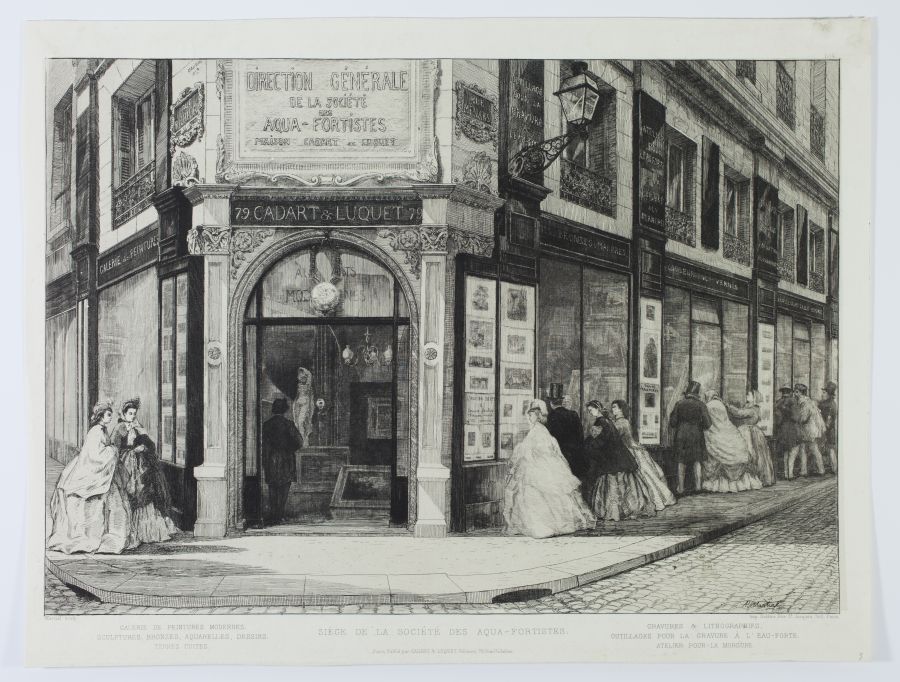Siège de la Société des Aqua-fortistes [The Headquarters of the Société des Aquafortistes]
Etching, 292 x 385 mm. Bailly-Herzberg p. 134.
Superb impression with dark contrasts, printed
on cream chine appliqué on cream wove
paper. Excellent condition. Impression trimmed 1 mm outside the platemark on
three sides and just inside the platemark on the left (without any loss of the
image).
The Headquarters of the Société des Aquafortistes
was published by the Société des Aquafortistes in the first issue of its third
year (1st September 1864). The ordinary edition was on laid paper. There was
also a luxury edition of 25 impressions before letter on Holland paper. This
impression, printed on
cream chine appliqué on wove paper,
was also probably a luxury impression. Prints bought through subscription could
also be sold separately, at a higher price point.
In front of the wide, richly furnished shop
windows, at the corner of the rue de Richelieu and the rue Ménars, connoisseurs
and curious people, men and women from all walks of life, are crowding
together, examining and commenting on the works on display: etchings,
paintings, drawings, sculptures... The year is 1864. Alfred Cadart opened his
store the previous year, after having separated from Félix Chevalier; together,
they had founded the Société des Aquafortistes in 1862. With Jules Luquet,
Alfred Cadart founded the company Cadart et Luquet, which moved to 79,
rue de Richelieu, trading at the sign Aux Arts modernes. The numerous
inscriptions on the façade, which Potémont also engraved under the picture,
list the products offered in the store. Works of art are available for sale:
paintings, engravings, lithographs, sculptures, bronzes, marbles and
terracottas, watercolours and drawings; but also artists’ supplies: tools for
etching, pigments and grounds. The building also housed a workshop where Cadart
and Luquet invited artists to come and try their hand at etching, declaring that
“they would be happy to show all those who would come to them the use of tools,
how to apply the different grounds, the details of the etching process, and the
various techniques that form the basis of etching” (Bailly-Herzberg, p. 22,
translated by us). Many artists did just that. Janine Bailly-Herzberg mentions
Degas in particular, who would make sketches of dancers from observation, and
would then visit Cadart to etch his sketches on a copperplate. Vollard also
tells us that Degas would create monotypes at Cadart's atelier, sometimes
highlighting them with pastel.
Among the thirty or so etchings exhibited in
the glass display cases between the large windows are the titles of two
publications: a Treatise on Etching, which emphasises the pedagogical
aims of the premises, and L'Ancien Paris, an important series of views
of Paris, in which Martial-Potémont recorded the changes that the capital was
undergoing. This publication, which
included 300 etchings, was the artist's first great success.
References: Janine Bailly-Herzberg: L’eau-forte de peintre au dix-neuvième siècle : La Société des aquafortistes, 1862-1867, Paris, 1972; Janine Bailly-Herzberg: Dictionnaire de l’estampe en France, 1830-1950, Paris, 1985.



